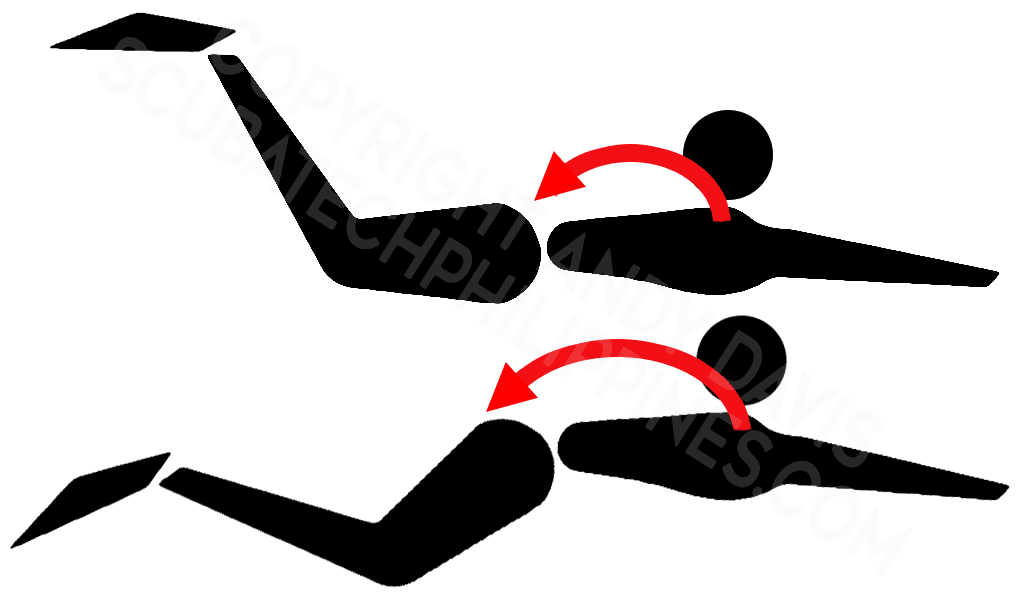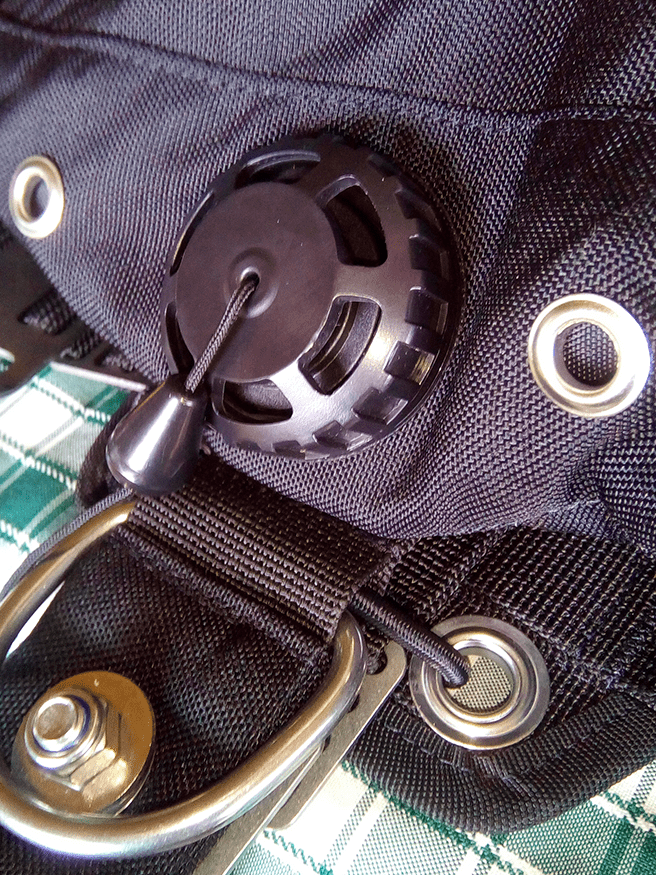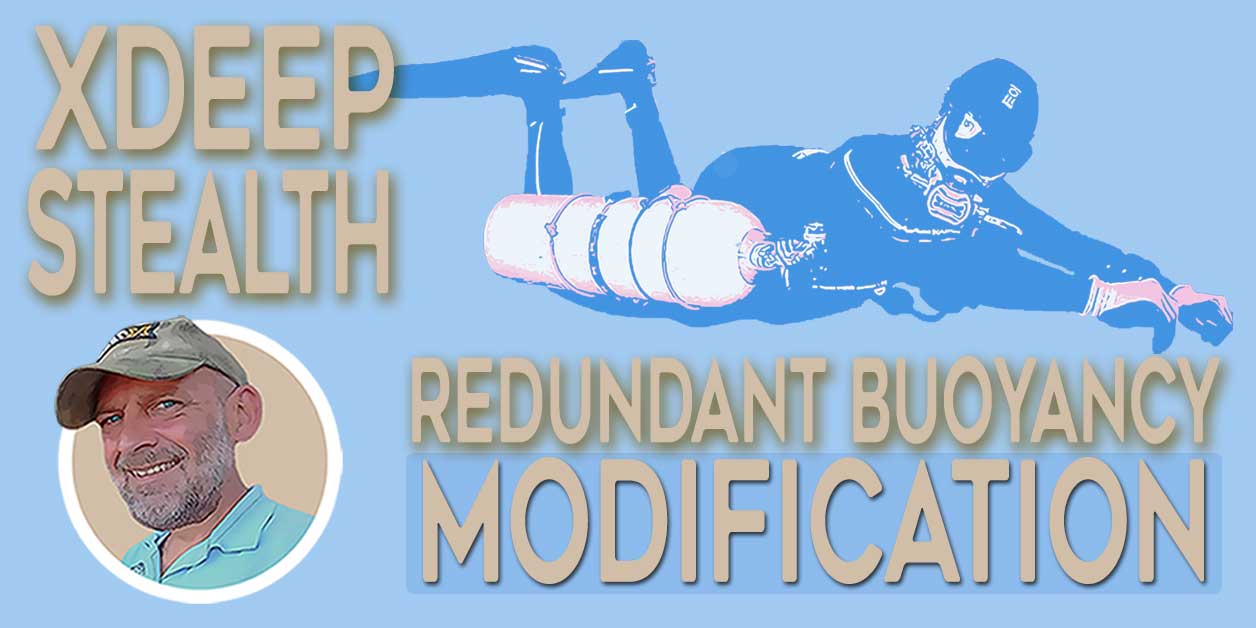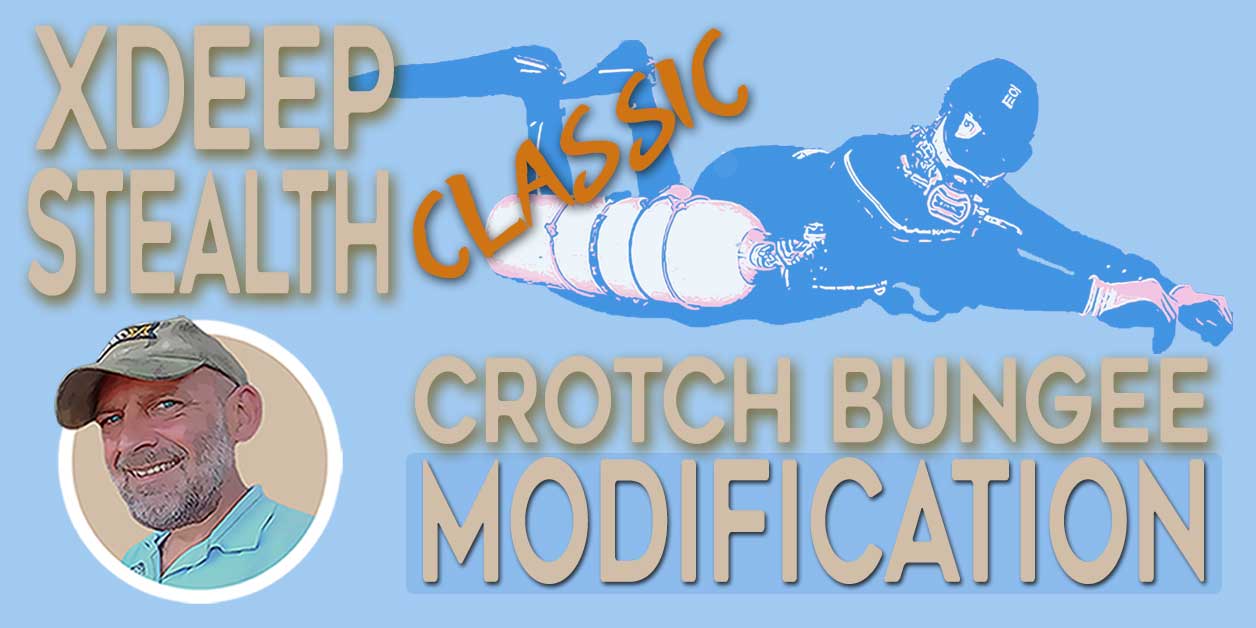Problems Reaching The XDeep Stealth Dump Valve
I occasionally hear sidemount divers report having problems reaching the XDeep Stealth dump valve. There are some simple solutions to this problem, but those solutions aren’t what many divers intuitively realize by themselves.
Why is the XDeep Stealth dump valve located at the bottom of the wing?
The decision by XDeep to locate the Stealth dump valve at the bottom centre of the wing is actually very clever and the outcome of extensive diving experience. It solves a critical safety problem that many divers may not have experienced and, thus, don’t perceive as a risk.
Wing gas emergencies invert sidemount divers feet-upwards
Because the majority of wing buoyancy is located around the lower torso, an instance of positive buoyancy will try to pull the diver into a legs-upward orientation. XDeep located their dump valve in the optimal position to vent gas from the wing under those circumstances.
When dump valves are located in other positions, such as the side hips or up on the shoulders, the diver has to manoeuvre their orientation horizontally and/or vertically against the effects of their wing buoyancy to get their dump valve into the highest position relative to their wing.
For routine buoyancy control, that small act of manoeuvring is inconsequential and barely noticed once it becomes habitual.
However, the need to manoeuvre oneself positionally becomes far more problematic when faced with emergencies like a rapid uncontrolled ascent or if the low-pressure inflator gets stuck open.
That additional time needed to manoeuvre before dumping, even if just a few seconds, is amplifying the severity of the emergency. The diver’s ascent rate is accelerating and the gas volume within their wing is expanding rapidly. As the gas volume inside the wing increases, so does the amount of physical exertion necessary to manoeuvre oneself against the buoyancy forces it creates.
The XDeep Stealth dump valve is located for emergencies
Uncontrolled ascents and LPI failures demand quick resolution. The location of the XDeep Stealth dump valve facilitates a quicker resolution by putting the valve exactly where it needs to be.
Personally, I admire diving equipment manufacturers who focus their design on maximising diver safety, rather than appealing to consumer compulsion towards convenience, familiarity and superficial functionality.
What causes problems reaching the XDeep Stealth dump valve?
In 99% of cases, this is a skills and equipment configuration problem, not an equipment design issue. Problems are most routinely encountered by novice sidemount divers and those switching over from rigs that locate the dump valve in a very different position; especially over-the-shoulder dump valves still used in some Florida-style sidemount systems.
Fundamental diving skills
First and foremost, weak fundamental skills can be to blame for problems reaching the XDeep Stealth dump valve.
In particular, horizontal trim plays an important role. If you’re not holding proper trim, with shoulders, hips and knees in flat alignment, then you will experience difficulty reaching backwards to access the dump valve and your sidemount pouch at the rear.
Allowing your body to bend at the hips, with your knees dropping, works against your shoulder’s range of movement as your reach behind.

You can experience that right now; simply stand erect with a straight spine and reach back to touch your coccyx. Then bend forward at the hips. You will feel increased shoulder strain and extension necessary to keep your hand in that position.
To a lesser extent, your overall fundamental skills competency plays a role in how quickly and easily you adapt to new equipment. Robust fundamental skills demand less cognitive exertion as you dive. When your fundamental skills are developed to an unconscious level of performance, you have a greater surplus cognitive capacity remaining available to focus upon skills adaption to new equipment.
Solid fundamental skills are critical for sidemount diving. If you don’t already devote some regular time to deliberate fundamental skills practice, you should consider doing so.
Being tempted into quick-fix solutions that don’t actually solve problems
Giving serious advice to help solve diving problems demands mentioning two frequently encountered issues; ego and instant gratification.
Ego
It can be beguiling to want to believe that a problem must originate from someone else’s mistake. For instance, “the XDeep Stealth dump valve is badly positioned“; blame is attributed to the equipment designers. That precludes thinking about whether the perceived problem has a more personal cause. When problem-solving your diving equipment and protocols always start with an honest assessment of yourself.
Instant-Gratification
Quick fixes have a powerful appeal. Our brains are evolutionarily wired to prefer the convenience and quick-easy judgements.
It is far more attractive to believe that a problem can be resolved in 30 minutes with some equipment tinkering and a little modification. The alternatives; spending hours comprehensively re-configuring your equipment system, or days working to remediate skill deficits, can be very unattractive.
Those two issues can lead divers into pursuing quick-fix equipment solutions that avoid or deny the underlying problems. At best, those solutions provide an awkward workaround for the issue. At worst, they create a spiral of issues where each solution creates further problems.
Fall into that spiral and your equipment configuration will inexorably degrade from bad to worse.
Examples of counter-productive quick-fix solutions:
- Putting a larger toggle or longer cord on the XDeep Stealth dump valve
- Adding weights onto aluminum sidemount cylinders
- Lengthening loop bungees to resolve difficulties donning your cylinders
- Switching to sliding waist D-rings because the sub-skill of manipulating cylinder boltsnaps is neglected
- Over-the-shoulder and shoulder-positioned dump valves*
*yes, diving equipment manufacturers do sometimes pander to consumers’ temptation for instant-gratification solutions.
Of course, there may be a few legitimate reasons why the solutions listed above might be a diver’s best available solution. What’s important is that they’ve actually done an honest evaluation of their problem or needs, and chosen a justifiably optimal solution, not just a convenient one.
Buy my ‘Sidemount: Principles For Success’ ebook now!

My comprehensive guide to sidemount configuration and development as a diver.
178 Pages. PDF format. Only $25
Fully Illustrated!
Chapters include:
- Sidemount history, design styles, and cylinder principles
- Harness and bungee setup and sizing
- Configuring deco/stage cylinders
- Diagnosing cylinder trim problems
- Regulators and hardware
- Training and skillset development
Six common problems making XDeep Stealth dump valve access difficult
There are six common equipment-related issues that impede access to the XDeep Stealth dump valve. I frequently observe sidemount divers having one, or more, of these issues:
1. When the XDeep wing is inflated, the dump valve raises several inches from the lumbar plate
This moves the dump valve upwards into a difficult-to-reach position; moving the hand outwards from the lower spine challenges your shoulder mobility. Variability of the dump valve position works against your muscle memory; it is best if the position remains consistent.
I created an equipment modification that solves this problem. Use some 6-8mm bungee to secure the wing to the lumber plate. and stop the wing from rising at the bottom when inflated.

2. The XDeep sidemount harness is improperly configured too high on the torso
The dump valve should be located just above the crease of the buttocks, not higher up the spine. Novice sidemount divers and those accustomed to using Florida-style systems without variable spine adjustment often neglect to adjust the lumbar plate into the correct position.
3. Out-of-trim sidemount cylinders are impeding arm maneuverability to the rear
One reason why horizontal cylinder trim is important is that it doesn’t hinder your access to the rear. Identify the causes of cylinder trim issues and fix them.
4. The XDeep sidemount harness is sized excessively tight, which effectively limits shoulder mobility; especially to the rear
The harness is sufficiently adjustable for any body shape in any type of exposure protection. Use a methodological step-by-step process for optimal sizing and adjusting your harness.
5. The sidemount diver is searching for the XDeep rear dump valve toggle with their fingers
Out-of-the-box, the XDeep Stealth dump valve toggle comes with an unnecessarily long length of cord; which allows the toggle to drop into difficult-to-reach positions.
Trim down the toggle cord to a minimum, keeping it as close to the dump valve as possible. It may seem counter-intuitive, but this makes the toggle much easier to find and utilize. Find the toggle by scissoring the dump valve with your fingers. This technique also helps a lot when tactile feedback is reduced when wearing thick dive gloves.
6. The sidemount diver hasn’t yet ingrained equipment familiarity with their XDeep Stealth BCD
The XDeep Stealth dump valve is in a unique position. When first diving an XDeep you won’t have ingrained muscle memory for operating a dump valve in that position. It is ego-comforting to dismiss equipment unfamiliarity and a lack of developed muscle memory as an equipment shortcoming.
Consider dump valve operation as a specific sub-skill.Invest time doing deliberate practice to develop that sub-skill.
Physiological issues making XDeep Stealth rear dump valve operation difficult
It is feasible that a diver could just have disproportionately short arms or very impaired shoulder mobility. As a rule of thumb, if you can reach behind and touch your coccyx then you can reach the XDeep Stealth rear dump.
In over a decade of exclusively teaching sidemount full-time to hundreds of students, I’ve only ever encountered one diver who had legitimate physiological problems reaching the XDeep Stealth dump valve.
In that single instance, we had to modify and extend the diver’s dump valve toggle cord; routing it further to the right-hand side of their wing.
These sorts of modifications are an absolute last resort. They are only implemented when every other potential factor has been ruled out.
About The Author

Andy Davis is a RAID, PADI TecRec, ANDI, BSAC, and SSI-qualified independent technical diving instructor who specializes in teaching sidemount, trimix, and advanced wreck diving courses.
Currently residing in Subic Bay, Philippines; he has amassed more than 10,000 open-circuit and CCR dives over three decades of challenging diving across the globe.
Andy has published numerous diving magazine articles and designed advanced certification courses for several dive training agencies, He regularly tests and reviews new dive gear for scuba equipment manufacturers. Andy is currently writing a series of advanced diving books and creating a range of tech diving clothing and accessories.
Prior to becoming a professional technical diving educator in 2006, Andy was a commissioned officer in the Royal Air Force and has served in Iraq, Afghanistan, Belize, and Cyprus.
In 2023, Andy was named in the “Who’s Who of Sidemount” list by GUE InDepth Magazine.
Purchase my exclusive diving ebooks!
Sidemount eBooks to download
Originally posted 2022-12-10 21:51:46.











